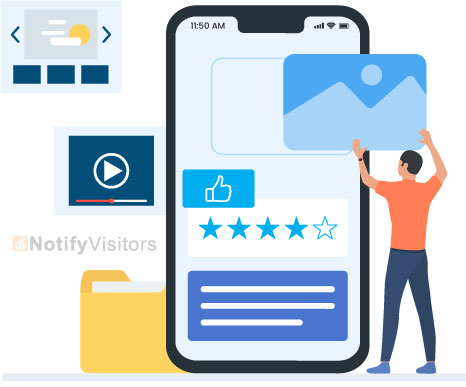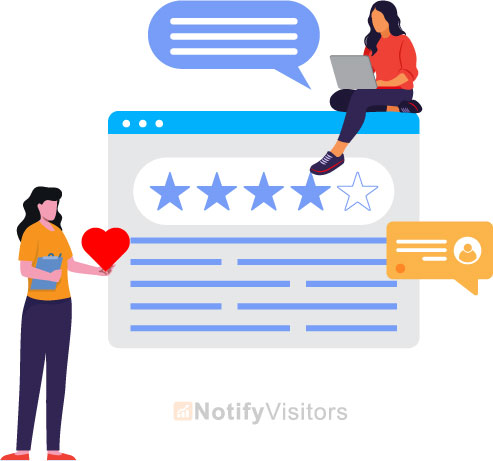People describe different brands in ways like practical, professional, weird, and more. You can direct people to represent your brand how you want to. You can do this through conscious and active branding.
It helps you shape your brand with control and intention. However, it is a meticulous process requiring many detailed tasks.
This blog discusses the branding process, stages, and strategies to improve brand identity. Knowing these will help you employ various steps to optimize your branding process.
Contents
What is Branding Process?
The process of branding involves a series of structured activities created for developing a communication framework and value system for a business, resulting in consistent brand identity.
Creating a brand identity important because:-
- Consistency in brand presentation and delivery positively influences the firm’s revenue generation.
- It takes 5 to 7 impressions for people to remember a brand (Pam Moore).
- Of the different branding elements, colour and design play a major role in brand recognition.
- Customers judge a new brand within 10 seconds (Crowdspring).
- Consistent branding measures taken across different marketing channels help businesses succeed.
- Branding maximizes the company’s recognition and enhances the brand’s awareness.
- Branding establishes trust and builds loyalty.
- Branding drives engagement and provides a competitive advantage.
- Branding creates a visual impact and leaves a memorable impression.
- Branding influences the decision-making process.
- Branding generates traffic, leads, and revenue.
- Branding can serve as one of your customer retention strategies.
- Branding widens the market reach.
- Branding increases a company’s worth.
- Branding increases the chances of gaining investors (Global Banking & Financial Review).
- It ensures the constant growth of leads and revenue.
- It increases the worth of the company.
That’s why businesses should make deliberate branding efforts.
What are the stages involved in the branding process?
The branding process comprises five stages.
- Carrying out research
- Developing a branding strategy
- Designing your logo and tagline
- Implementation
- Managing your branding efforts
1. Carrying Out Research

The foremost step in the branding process is conducting keyword research with Semrush to identify your brand’s current position and investigate the direction in which you should go to amplify your potential.
Performing research facilitates the establishment of a clear vision, goals, values, and strategies for your company.
It also helps you understand your firm’s mission, target markets, strengths, weaknesses, brand personality, and more. So, start by asking your key management and stakeholders several questions about their views and perceptions of your brand.
Here are some examples-
- ‘Why did you choose our brand?’
- ‘What is important to you when it comes to our offerings?’
- ‘How do you rate us?’
- ‘What 3 words would you use to express our brand/company?’
- ‘What can be improved in our brand.’
- Analyze their answers and put them together to determine the brand strategy.
2. Developing a Branding Strategy

A brand strategy tells you the direction in which your brand should move so that it can grow.
You should develop your brand strategy by combining creative imagination with rational thinking. It should work internally for the company and externally for its customers.
From the company’s perspective, think well about how you wish to portray your brand. And from the customers’ view, think of what they look for in your niche and whether your brand fulfils that.
Creating a unique brand experience is essential to differentiate your brand and build a loyal customer base that resonates with your values and promise
While coming up with a brand strategy, instead of trying to include too many things, narrow down your focus. Taking the help of a professional is good. He can bring out your brand essence, which your brand should become known for.
3. Designing your logo and tagline
Go through your brand’s analysis and strategy report, and then apply your intelligence, creativity, and imagination to develop a visual representation of your brand. You may come up with several ideas that you can condense into a single final concept. You may come up with several ideas that you can condense into a single final concept.
When designing your brand identity, you should consider key areas and ensure they precisely represent the personality and values established in the strategy.
A logo is an ultimate thing that will help establish your brand identity. It will be your brand’s visual representation. Get the right mix of icons, images, shapes, fonts, and colours to create an eye-catching, unique, and illustrative of your brand. For an eye-catching logo, you can use a logo maker. Likewise, create a tagline that truly represents your brand.
Later on whether you create AI presentation make a promotional video or use presentation templates it’s important to use these visuals to reinforce your brand identity consistently.
In addition, consider utilizing a custom QR code generator to turn your logo into a QR code has the potential to open up a world of digital opportunities. Customers can use their phones to quickly scan the logo and view digital content on the fly. Also, having a QR code embedded into a logo helps establish a tech-savvy brand that caters to modern audiences and stays ahead of competition. Android device management is essential to ensure smooth operations and security in this digital landscape
4. Implementation

Now that you’ve created your brand identity, you need to disseminate it through different marketing mediums such as websites, folders, advertisements, letterhead, social media pages, flyer templates, business cards, brochures, leaflets, banners, vehicles, uniforms, etc. You can also create posters that will reflect your brand identity. Use a poster maker to create professionally looking posters that will leave a lasting impression on your audience.
These collaterals are the points of contact between your company and your customers. So, unlike the previous stages where everything was just confined to paper, this stage will put things to work.
The vital aspect of this branding stage is to develop a consistent yet flexible look and feel across all touchpoints. And this look and feel should represent every value set out in the strategy.
Ensure that the final look and feel is feasible both online and offline, at large and small scale, and in targeting all possible markets. Principally, it should be able to visually express itself across every application.
5. Managing your Branding Efforts
It requires a long-term commitment from you (the business owner), your partners, and your directors to manage your brand identity assets. To do this successfully, ongoing monitoring and input are needed.
There are four steps involved in this process.
- An internal and external brand launch: First, launch your brand internally so that your employees get acquainted with the different aspects of your brand and understand how they can communicate it with customers while interacting with them. When you launch it externally, you can choose to do it through a sequence of marketing messages or over an event. Make sure that you reinforce your message several times.
- Conveying the new brand identity to customers and employees:
Here are the questions you need to ask yourself while doing this:-
- Who needs to know your brand identity?
- Why do they need to know it?
- What do they need to know?
- Will the alteration affect them?
- What are the channels through which you’ll reach them?
- When will you reach out to them?
- Developing guidelines for your branding: You need to develop some branding guidelines for your employees so that brand consistency is maintained across all applications. This will facilitate collaborative working towards building your brand.
- Designating roles: Assign specific roles related to your branding process to specific employees. This will help them absorb the company culture and invest in the brand.
5 Strategies to Improve Brand Identity
1. Educate your customers

Your branding efforts should be based on the needs and desires of customers. Apart from offering value, you should also educate them about your brand.
You need to teach them how your offerings solve an issue they’re facing. You can impart this knowledge through various marketing channels like your website, emails, social media, and more. A video format is a great way to share this information. Create video content explaining your brand offerings and value proposition. Free screen recorder tools like Screen-Recorder can help you create these professional videos with minimum effort.
2. Stop selling and be helpful.
The second most important strategy in the branding process is to be helpful rather than extensively promoting your products. Customers hate being treated as money-generating machines.
So, get helpful by responding to issues in your niche discussed on social media. This will help initiate quality engagement and build trust, which eventually can lead to brand loyalty and word-of-mouth spread of your brand.
3. Develop your marketing personas

Always remember that your marketing messages aren’t reaching a homogenous audience. Your marketing personas certainly differ with different channels.
So, using the same content across different networks won’t work or generate the same response. Therefore, create multiple personas and post content accordingly to streamline the creation of your content for different mediums, use a content collaboration tool. and use custom tailored invoices resonating your brand.
4. Establish your brand voice and tone
Your brand’s voice and tone matter next to its visual identity. Choose from various personalities such as entertaining, informative, humorous, sarcastic, and more.
But whatever you pick, make sure that it resonates well with your brand and that you stick to it across all your communications. Develop strict guidelines in this regard and share them with your team. Moreover, utilizing custom packaging solutions like Arka can further reinforce your brand’s identity and leave a lasting impression on your customers.
5. Network to build goodwill

Whenever your business makes a new connection, send them a thank you message with a content gift that doesn’t relate to your business.
For instance, it can be a link to a blog offering health tips or motivational quotes. This will help build goodwill, which can pave the way for initiating two-way conversations.
How email marketing can help you do branding?
Email marketing can be a powerful tool for building and strengthening your brand in several ways:
- Consistent Communication & Brand Identity: Regular email communication helps you stay top-of-mind with your audience. By maintaining a consistent brand voice, tone, and visual identity in your emails, you create a recognizable image and solidify your brand in the minds of your subscribers.
- Building Relationships & Trust: Emails allow you to connect with your audience on a more personal level. Sharing valuable content, industry insights, or behind-the-scenes glimpses into your company culture fosters trust and builds stronger relationships with your subscribers.
- Targeted Messaging & Personalization: Segmentation allows you to tailor your email content to specific audience segments based on interests, demographics, or purchase history. Personalized emails resonate better with subscribers, increasing engagement and brand loyalty.
- Sharing Your Story & Values: Emails offer the perfect platform to showcase your brand story, mission, and values. By sharing your company’s heart and soul, you connect with like-minded customers who identify with your brand philosophy.
- Promoting Brand Advocates: Engaging email content can turn subscribers into brand advocates. Encourage customer reviews, testimonials, or social media shares within your emails. Positive word-of-mouth from satisfied customers strengthens brand credibility and attracts new audiences. Using such referral / loyalty program you can increase branding and promote it via providing branded goodies for example you can use Imprint and send those goodies with your brand name.
- Owning Your Audience & Data: Unlike social media platforms where algorithms control reach, email marketing allows you to directly connect with your subscribers. You own your email list and customer data, giving you more control over your brand messaging and marketing efforts.
Email marketing, when used strategically, can be a valuable asset for building brand awareness, fostering trust, and creating a loyal customer base.
Wrapping up
Branding is essential for a business if it wants to be recognized, establish trust and loyalty, retain customers, gain more traffic and leads, drive engagement, leave a memorable impression, gain a competitive advantage, widen its market reach, enhance its worth, beat the competition, constantly grow, gain investors, and increase its revenue.
This blog has listed and discussed the steps involved in the branding process. It has also discussed five effective strategies to improve brand identity. Do make use of them to succeed in your branding efforts.
FAQs
1. What is branding?
Branding is the process of consistently creating a strong, favourable perception of a firm and its offerings in the customers’ minds via the usage of elements such as design, theme, tone, values, etc., across all marketing collaterals.
2. What are brand elements?
A brand’s name, colour, fonts, themes, tone, and style comprise its brand elements. By being consistent in these elements, you can create a consistent and recognizable visual representation of your brand.
3. Why is branding important?
Companies can create a unique brand image by making effective branding efforts. And this can have a favourable impact on your bottom line by acquiring and retaining customers, beating competition, and more.

























 Email
Email SMS
SMS Whatsapp
Whatsapp Web Push
Web Push App Push
App Push Popups
Popups Channel A/B Testing
Channel A/B Testing  Control groups Analysis
Control groups Analysis Frequency Capping
Frequency Capping Funnel Analysis
Funnel Analysis Cohort Analysis
Cohort Analysis RFM Analysis
RFM Analysis Signup Forms
Signup Forms Surveys
Surveys NPS
NPS Landing pages personalization
Landing pages personalization  Website A/B Testing
Website A/B Testing  PWA/TWA
PWA/TWA Heatmaps
Heatmaps Session Recording
Session Recording Wix
Wix Shopify
Shopify Magento
Magento Woocommerce
Woocommerce eCommerce D2C
eCommerce D2C  Mutual Funds
Mutual Funds Insurance
Insurance Lending
Lending  Recipes
Recipes  Product Updates
Product Updates App Marketplace
App Marketplace Academy
Academy

